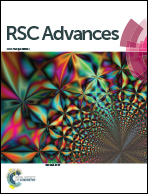PEI@Mg2SiO4: an efficient carbon dioxide and nitrophenol compounds adsorbing material†
Abstract
The PEI@Mg2SiO4 hybrid composite is readily synthesized for adsorbing carbon dioxide (CO2) and nitrophenol compounds (NACs), in which more than 11% PEI is embedded. By the removal rate of 4-nitrophenol (10 mg L−1) and the capture capacity of CO2, the Mg2+ : PEI : SiO32− optimal mole ratio of the PEI@Mg2SiO4 is 1 : 0.6 : 1.5. The composite shows the highest adsorption amounts of 0.94 mmol g−1 CO2 at 50 °C. The heat treatment regeneration exhibits a good stability, e.g. the CO2 capture capacity decreases by only 20% after four cycles, and the desorption rate of CO2 remains more than 91%. It also exhibites a fast adsorption and high capacity for 4-nitrophenol (NP), 2,4-dinitrophenol (DNP) and 2,4,6-trinitrophenyl group (TNP). The adsorption capacity of NP, DNP and TNP is 2.40 mmol g−1, 2.66 mmol g−1 and 4.85 mmol g−1 respectively, which is more than that of the conventional sorbents. This work presents the higher capacity and eco–friendly sorbent for CO2 and nitrophenol compounds.


 Please wait while we load your content...
Please wait while we load your content...